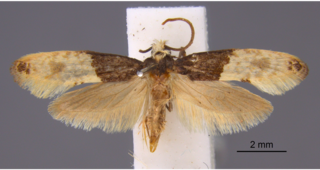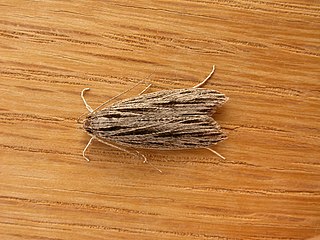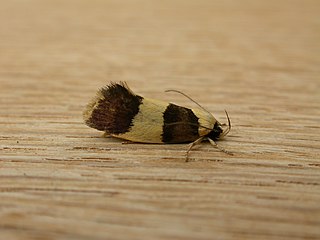
Trichophaga tapetzella, the tapestry moth or carpet moth, is a moth of the family Tineidae. It is found worldwide.

Leistarcha scitissimella is a moth of the family Xyloryctidae. It is found in Australia, where it has been recorded from the Australian Capital Territory, New South Wales and Queensland.

Agriophara gravis is a moth of the family Depressariidae. It is found in Australia, where it has been recorded from New South Wales and Tasmania.

Plectophila discalis is a moth of the family Xyloryctidae first described by Francis Walker in 1865. It is found in Australia, where it has been recorded from New South Wales, Queensland and Victoria.
Dolichobela is a monotypic moth genus of the family Crambidae described by Alfred Jefferis Turner in 1932. It contains only one species, Dolichobela celidograpta, described in the same publication, which is found in Australia, where it has been recorded from Queensland.

Leucania loreyi, the cosmopolitan, false army worm or nightfeeding rice armyworm, is a moth of the family Noctuidae. It is found in most of African countries, the Indo-Australian subtropics and tropics of India, Sri Lanka, Myanmar, the eastern Palearctic realm, and the Near East and Middle East. The species was first described by Philogène Auguste Joseph Duponchel in 1827.
Batrachedra eremochtha is a species of moth of the family Batrachedridae. It is found in Australia.
Batrachedra trimeris is a species of moth of the family Batrachedridae. It is found in Australia.

Tiracola plagiata, the cacao armyworm, is a moth of the family Noctuidae. The species was first described by Francis Walker in 1857. It is found from south-east Asia, South India, Sri Lanka, Myanmar to the South Pacific Islands, including the northern two-thirds of Australia.

Telecrates laetiorella is a moth of the family Xyloryctidae. It is known from the Australian Capital Territory, New South Wales, Queensland, South Australia and Victoria.
Holocola phaeoscia is a species of moth of the family Tortricidae. It is found in Australia, where it has been recorded from Queensland and New South Wales.
Dichelopa dichroa is a species of moth of the family Tortricidae. It is found in Australia, where it has been recorded from South Australia, Victoria and New South Wales.
Garrha carnea is a moth in the family Oecophoridae. It was described by Zeller in 1855. It is found in Australia, where it has been recorded from Queensland, New South Wales, Victoria, Tasmania and South Australia.
Zaphanaula hemileuca is a moth in the family Xyloryctidae, and the only species in the genus Zaphanaula. It was described by Turner in 1896. It is found in Australia, where it has been recorded from Queensland.
Boydia stenadelpha is a moth in the family Xyloryctidae. It was described by Oswald Bertram Lower in 1905. It is found in Australia, where it has been recorded from New South Wales.
Clerarcha poliochyta is a moth in the family Xyloryctidae. It was described by Turner in 1902. It is found in Australia, where it has been recorded from the Northern Territory and Queensland.
Cryptophasa atecmarta is a moth in the family Xyloryctidae. It was described by Turner in 1917. It is found in Australia, where it has been recorded from New South Wales, Queensland and Western Australia.
Cryptophasa opalina is a moth in the family Xyloryctidae. It was described by Turner in 1900. It is found in Australia, where it has been recorded from the Northern Territory, Queensland and Western Australia.
Lichenaula tortriciformis is a moth in the family Xyloryctidae. It was described by Thomas Pennington Lucas in 1900. It is found in Australia, where it has been recorded from Queensland.
Xylorycta melaleucae is a moth in the family Xyloryctidae. It was described by Turner in 1898. It is found in Australia, where it has been recorded from New South Wales and Queensland.






